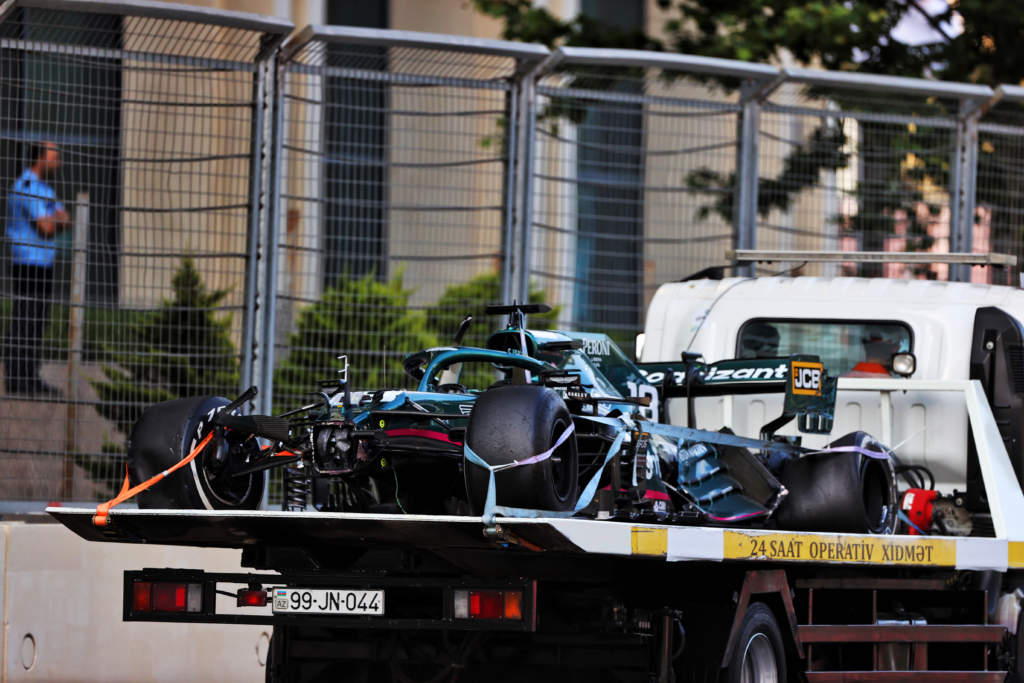Up Next

There has certainly been plenty of talk about tyres in Formula 1 in recent weeks. Even before the failures during the Azerbaijan Grand Prix happened and put Pirelli under even more scrutiny, we heard constantly about drivers struggling with tyre warm-up or, as most call it, getting the tyre into the working window.
We’ve heard this from Mercedes in particular. But when you consider that Mercedes spent a lot of time and money during 2019 to come up with its DAS (dual axis steering), it has struggled with this for some time.
It spent all of 2020 benefitting from having this in the toolbox to mitigate the problem, which appeared to work well given Mercedes had one of its most dominant seasons with 15 pole positions and 13 wins from 17 races. Its season dropped off late on just as Red Bull came on strongly at a point when Mercedes said it had stopped development to focus on its 2021 version of more or less the same car.
It’s not really a surprise that Mercedes is a bit behind the others when it comes to getting the tyres into the working window. It spent last season using DAS to solve that problem, so when it’s banned but you don’t spend time finding solutions to sorting it some other way, as other teams have had to, it will be more difficult.
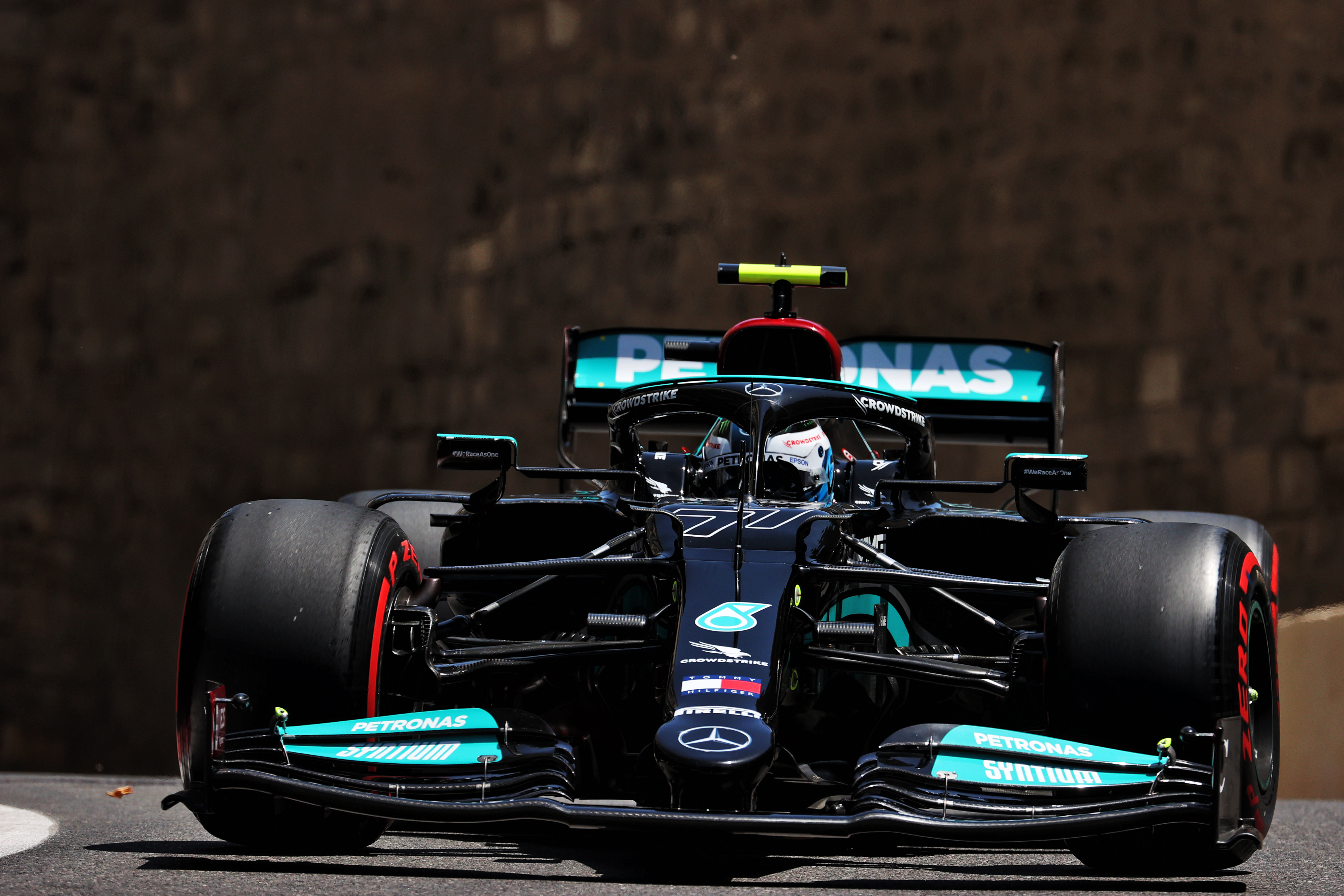
Temperature is not really the problem. But it’s the ‘working window’ that everyone talks about. It’s like buying a new pair of leather shoes; you need to wear them a few times before they really become comfortable. They need to free up, just like the tyres do before they become compliant. And when the tyres are loaded by something like 6g under braking and 5g laterally, it gives the structure a bit of a hammering.
Let’s take these forces and turn them into numbers. Let’s assume the car weighs 800 kilos and has a 60/40 weight distribution and that 80% of that cornering load is reacted on the outside tyres. This means that if the tyre tread were nailed down through the contact patch, the load generated on the wheel going through the tyre side wall would be 1920kg on the outside rear and 1200kg on the outside front.
While all this is happening, with the same aero distribution there is a vertical load that could be up to 900kg on each rear tyre and 600kg on the fronts. This is all happening while the rear tyres are delivering the power unit’s torque and are rotating at roughly 2500rpm.
So it’s not an easy life for these the black, round things. But still, they need to be able to do the job safely.
We saw the carcass failure of Lance Stroll’s rear tyre in Baku up close, so we can see what’s in a tyre. There’s no way all those cords are equally-loaded when the tyre is first produced, so to get the tighter ones freed up and the loose ones to take some of the strain the tyre needs to be run under load.
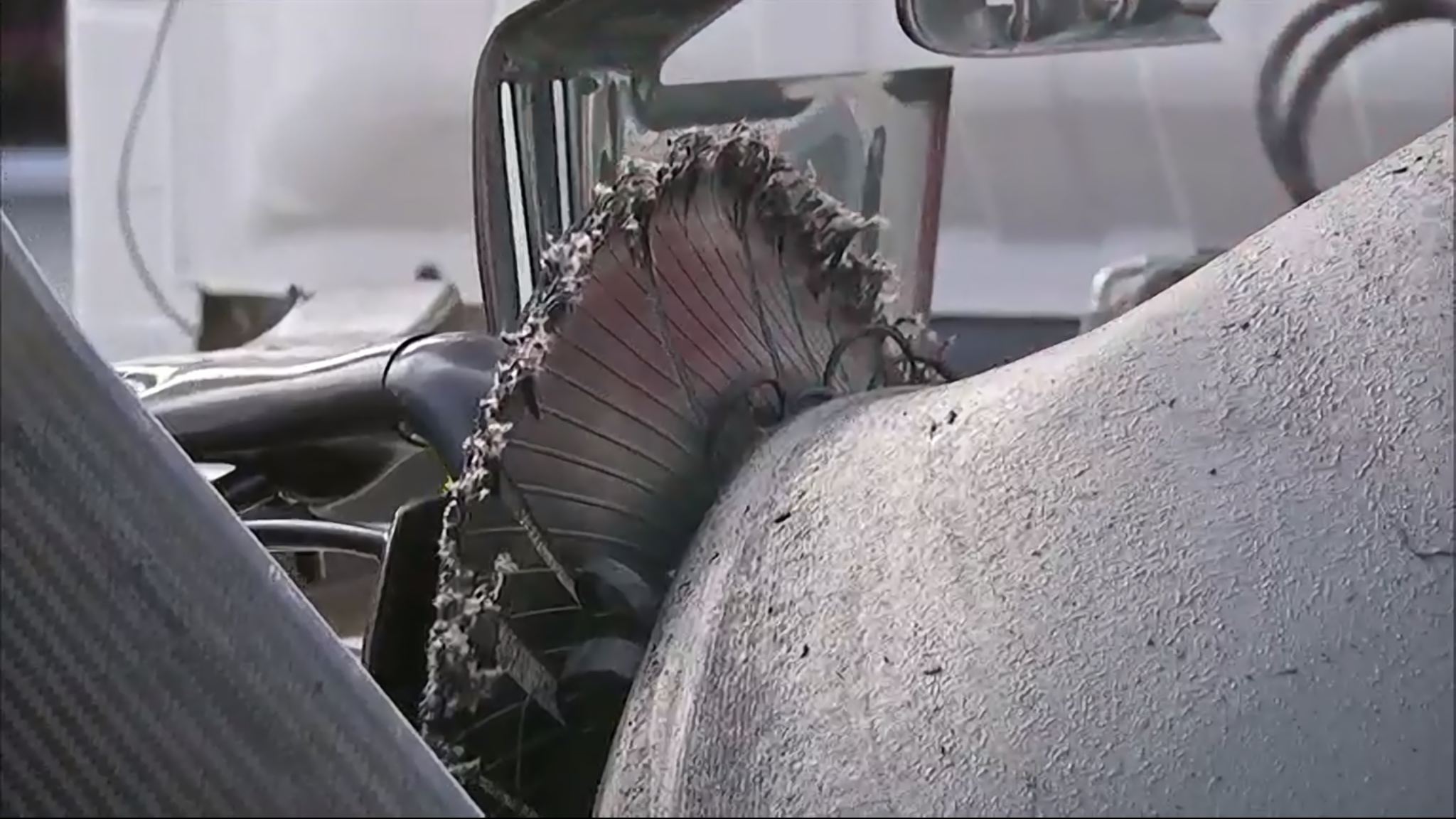
Some of this process will happen if you pump the tyres up to as high a pressure as Pirelli allows, but the forces this will induce are still nothing like what will be seen on the circuit when on a fast lap. All this weaving around on a warm-up lap is basically a waste of time. Yes, it will induce some front tread temperature but that’s it.
Before the tyres go into the blankets, I would pump them up to their maximum allowable pressure and leave them for a set amount of time. Then, I would reduce the pressures and wrap them in the blankets.
Pirelli issues tyre starting parameters for each race. For Baku, it was as follows:
Front tyres: 100C maximum and 20psi minimum when taken out of blankets.
Maximum camber at end of straight -3.5 degrees negative (top leaning in)
Rear tyres: 80C maximum and on Friday 19psi, Saturday 20psi when taken out of blankets.
Maximum camber at end of straight: -2.5 degrees negative (top leaning in)
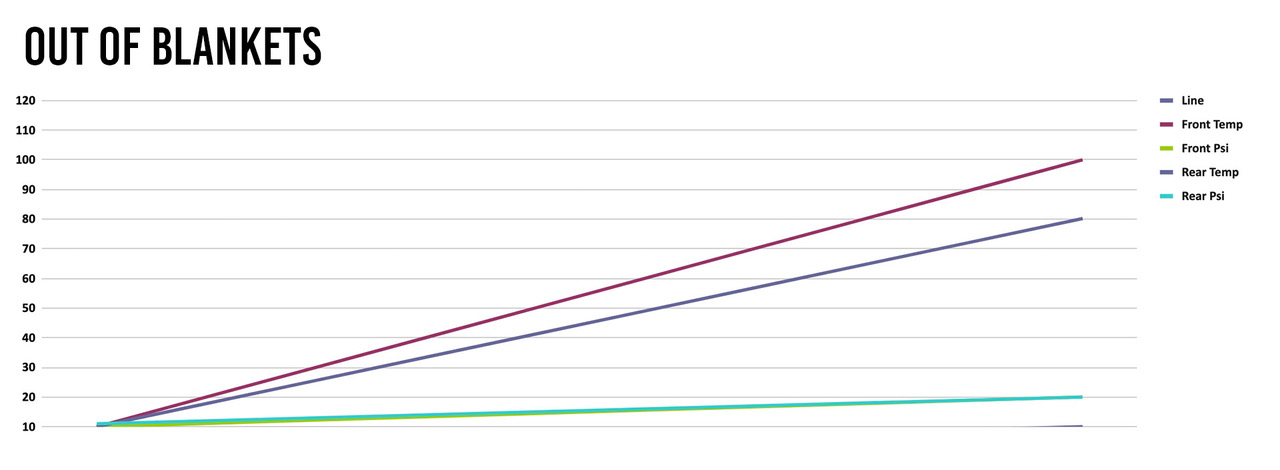
So when the blankets come off, there’s no real problems with temperature, as a matter of fact it would be very easy to cook (harden the compound) the tyres if they were left at this temperature for very long. These graphs show the gradient of the increase in temperature and pressure against time. Assuming that the energy put in is the same, the rear being bigger with more volume will take a little longer to reach its maximum temperature, which is also 20C lower than the fronts.
It’s what happens next that generates most of the problems. On most occasions, the teams are in no hurry to get the car out of the pits. This is because they want the pressures to drop and although they don’t want to lose temperature unfortunately both go hand in hand.
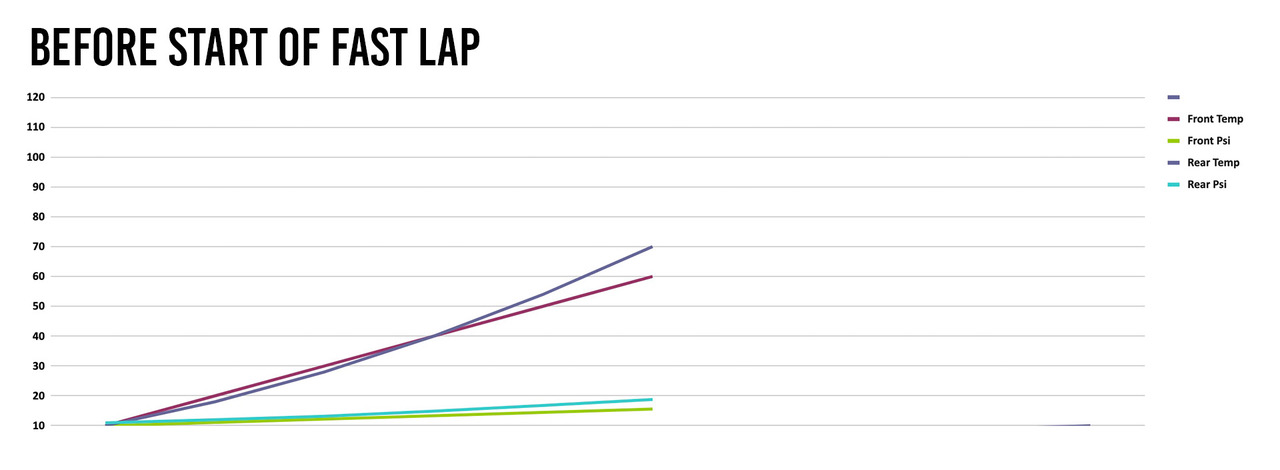
On the warm-up lap, which in reality is a pressure reduction lap the rears are driving the car and the driver has close to 1000bhp at hand so the rear tyres will come back up in temperature, but the fronts will lag behind.

This is why we see lock-ups or a car understeering and going wide at the first corner. As you brake for the first corner, the temperatures are starting to come back up into the working window that they perform best at.
As you can see, the front tyres are doing more than the rears under braking and corner entry, so heat up that bit faster.
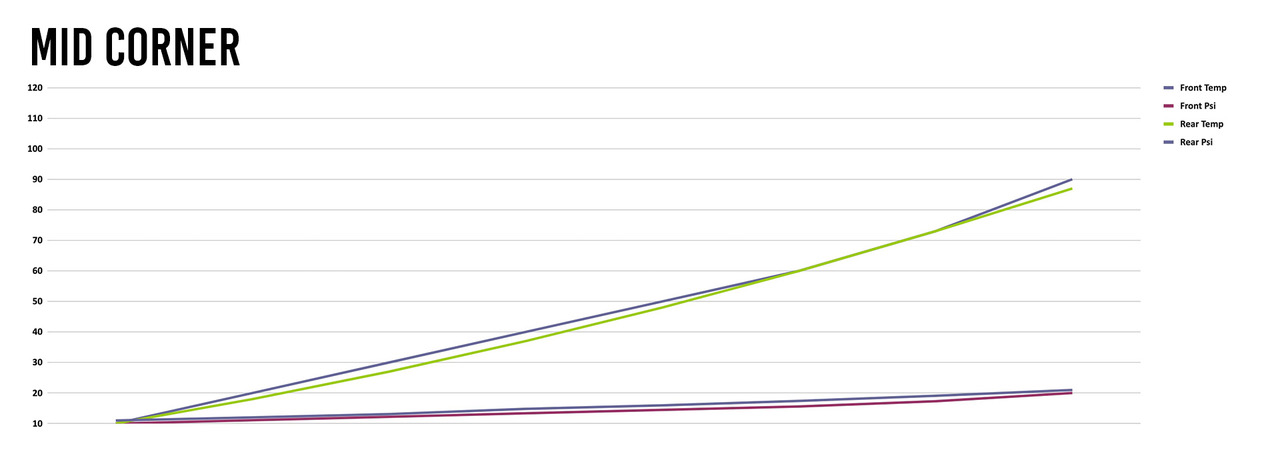
By mid-corner, temperature wise they have more or less equalised. This is because if my weight distribution of 60/40 is anywhere near correct, the rears are doing more work mid-corner than the fronts so the temperature increases.
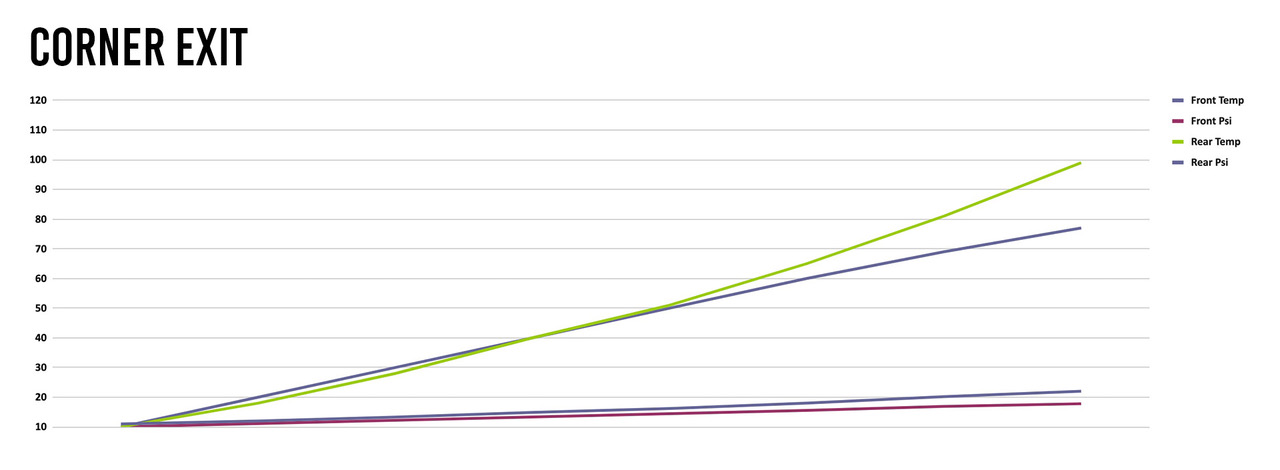
By the corner exit, when the driver is getting back on the throttle, the rears are doing most of the work. Depending on the level of wheelspin, this rear temperature could easily reach in excess of 100C. If you keep that cycle going for a few corners the rears will very soon overheat.
On the circuit, you are probably seeing a tyre temperature cycle from 80-120C with the rears just that little bit hotter than the fronts, As my graphs show, the front and rear will not be equal because their workload is fairly different. But they will cross over through a corner, with the front heating up first on entry to mid corner and then the rear overtaking it from mid-corner to exit.
If all the teams stick to Pirelli’s tyre parameters sheet then other than overheating the rears by being a bit heavy handed with the throttle which will lead to increased rear tyre pressures reducing the rear grip even more then everyone is in the same boat, or in this case on the same tyres.
Now for the big problem – the tyre failures in Baku. Pirelli has said there were no structural failures or punctures and that the teams were operating the tyres within the defined parameters. The teams involved, Red Bull and Aston Martin, have both stated they worked within Pirelli’s parameters. So that suggests there was no problem and what we saw didn’t happen! But clearly it did.
Pirelli’s original statement was a little bit confusing as it seemed to be hinting at something, but as Mario Isola explained on Thursday evening the lack of a common tyre pressure sensor, which is introduced next year, means that it’s only the starting pressures that are regulated.
“I cannot say that they were doing something against the regulations in their search for more performance because if they respect the starting pressure they are complying with our regulation,” said Isola.
“If the same happens next year when we with a standard sensor impose a running pressure, in that case, they are against the regulations. But this is not the case this year, and it is not possible to do that simply because we don’t have a sensor where we can rely on measurement.”
The starting pressures are set at a level to result in what Pirelli expects to be the running pressures that it wants, but when you have 10 F1 teams each with hundreds of people they usually will find a way to defy your expectations.
So the tyres were running at lower pressures than Pirelli wanted, but they were running to the regulations – leading to the introduction of some new tyre protocols and also the raising of the rear pressures to 21.5psi with a target running pressure of greater than or equal to 22.5psi.

The two failures in Azerbaijan, which were both described as circumferential cuts on the inside shoulder, were on very different cars with different characteristics. This includes differences in the aero distribution, the weight distribution, the braking characteristics and distribution, how the differential was operating, the rear toe, camber and camber change to name just a few things. It’s never easy to find a common thread for these things but let’s go through a few possible scenarios.
Stroll’s failure happened at the end of his 30th lap. He started the race on these tyres and I’m happy to assume that Aston Martin did comply with Pirelli’s temperature and pressure requirements. This set of hards would have been fitted new on the grid and would then have completed a fairly slow warm-up laps, like everyone else’s.
Verstappen changed from his starting softs to hards after 12 laps but Stroll stayed on his starting hards. Then when he crashed after his failure, Verstappen slowed under the safety car.
My question would be what were the tyre pressures on Stroll’s car at the actual race start and Verstappen’s car just before the restart?
Verstappen himself has been very vocal about the situation and rightly so, he was the one looking at a wall coming up at pushing 200mph, stressing that the tyre pressures were correct. His interpretation of the situation is that Pirelli is being as vague as many others think it is.
“The only thing I can say is from our side the team did everything like they should have done,” said Verstappen. “They followed all the guidelines with tyre pressures and stuff so it was nothing to be found there. So, I don’t really get it.
“We will go up on pressures here for this weekend, I’m actually 100% sure we will. Probably it had something to do with what happened in Baku. But it would also be nice to just know if it was tyre pressure related.
“Just speak out, that would be easier to understand the explanation we got so far, because the team didn’t do anything wrong.”

We have heard on many occasions drivers complaining about the slow speed of the safety car and if the tyres are worn a bit worries about getting them back up to temperature. If the tyres were down to 50/60C, then the pressures will be in line with that which could mean that they are down around the 14/15psi mark.
When the safety car comes in after an interlude, the trend is now to go to more or less the start/finish line at a snail’s pace before hitting the gas pedal. After that, it is down to who can survive the best while the tyres heat up and come up to pressure.
But during that time, the pressures are well below their required level so every corner and every straight that the cars travels along can potentially damage a tyre.
As Sebastian Vettel said when asked if he trusted the Pirellis: “I think the short answer would be, I can’t say 100% yes, and I can’t say 100% no.” Given his position as a Grand Prix Drivers’ Association director, it’s very clear that the drivers have concerns about the risks of tyre damage.
So is there a quick fix for this problem?
Pirelli will take the simple route of increasing pressure to reduce the deflection on the tyre sidewall. However this will only lead to less rear grip in slow corners, higher rear tread temperatures, more wheelspin and more complaints from the drivers.
As usual I don’t mind sticking my neck out with a couple of suggestions.
1) Reduce the maximum end of straight rear camber from -2.5 negative to -1.5 negative. This will reduce the load on the inside tyre shoulder when the car is on the straights, improve traction out of slow corners so reduce excessive tread temperatures, it will also reduce lateral grip in fast corners which will reduce the load in the tyre side wall. All three are positive changes to ease the same problem.
2) When the safety car comes in, which is a process that could be speeded up, and the drivers are all ready to go and in line then there is no overtaking for one lap as an interim step.
That means that the lead driver can define the pace at a level to allow everyone to warm up their tyres – but more importantly get the pressures up to a reasonable level.
Then the next time across the start/finish line it’s all hell breaks loose.


